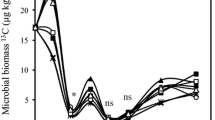Abstract
A 21-day lab incubation experiment was carried out with arable soil and uniform 13C-labeled wheat residues. Residue-derived amino sugars (ASR) accumulated exponentially and were fitted with a first-order model C t = CMax(1 − e−kt) well. Their maxima were 88–381 nmol g−1 for glucosamine (GluNR), 52–105 nmol g−1 for galactosamine (GalNR), and 107–137 nmol g−1 for muramic acid (MurNR), respectively. Their half-lives (T 1/2) separately varied between 1.2 and 3.3 days for GluNR, 1.6 and 4.7 days for GalNR, and less than 0.3 day for MurNR. A close relationship was observed between carbon mineralization and ASR (P < 0.05), and carbon use efficiency of cumulative ASR was calculated and compared.
Access provided by Autonomous University of Puebla. Download conference paper PDF
Similar content being viewed by others
Keywords
Introduction
Though amino sugars (AS) have widely been used to investigate microbial residues and correlated organic compounds sequestration, little is known about their formation dynamics in soil (Zhang and Amelung 1996; He et al. 2011). Difficulties are probably ascribed to the definition and differentiation of varied ASs pools, substrate availability, and time scale of the study. With 13C-labeled residues’ incubation, LC-c-IRMS was utilized to investigate AS formation kinetics and its carbon use efficiency for the first time in this study.
Materials and Methods
0–10-cm top soil from conventional till (CT) and no till (NT) was amended with 13C-labeled wheat grain (G), leaf (L), and root (R) at 6-mg substrate Cg−1 for a 21-day incubation, including six treatments: NG (NT + G), NL (NT + L), NR (NT + R), CG (CT + G), CL (CT + L), and CR (CT + R). Concentrations and δ 13C of AS were determined by LC-c-IRMS. Residue-derived AS (ASR) formation was described in ASR,t = ASR,Max ∙ (1 − e−kt), where ASR,Max is potentially accumulative ASR,t , and k is ASR,t the formation rate constant, and t is the incubation time.
Results and Discussion
This study showed that T 1/2 of ASR formation increased as MurN (≤0.3 day) < GluN (1.2–3.3 days) < GalN (1.6–4.7days); their maxima were 88–381 nmol g−1 for GluN, 52–105 nmol g−1 for GalN, and 107–137 nmol g−1 for MurN; and ASR,Max/ASSOM,0h were separately 14.9–17.8% for MurN, 5.5–13.0% for GluN, and 2.7–6.3% for GalN (ASSOM data not shown) (Fig. 1, Table 1), which agrees with previous studies (Glaser and Gross 2005). MurN is exclusively originated from bacteria, and its faster formation suggested the important role of bacteria at the early stage of mineralization of wheat residues.
The cumulative GluNR or GalNR was significantly correlated to the mineralized carbon (CM) across all treatments throughout the whole incubation, which strongly suggests that a certain proportion of CM is allocated into newly formed ASR (except for MurNR, Fig. 2). The intercepts and slopes of linear functions between GluNR and CM were evidently different from their counterparts between GalNR and CM, which clearly signifies a much higher carbon use efficiency of accumulative GluNR than GalNR. The stoichiometric relationship between CM and ASR could be calculated: an increase of 0.1 μmol GluNR needed 0.38 μmol CM, which was 13.61 lower than GalNR, while after 1 μmol CM, 0.16 μmol GluNR would be synthesized, which was nearly 16 times the GalNR.
References
Glaser, B., and S. Gross. 2005. Compound-specific δ13C analysis of individual amino sugars–a tool to quantify timing and amount of soil microbial residue stabilization. Rapid Communications in Mass Spectrometry 19: 1409–1416.
He, H.B., X.B. Li, W. Zhang, and X.D. Zhang. 2011. Differentiating the dynamics of native and newly immobilized amino sugars in soil frequently amended with inorganic nitrogen and glucose. European Journal of Soil Science 62: 144–151.
Zhang, X.D., and W. Amelung. 1996. Gas chromatographic determination of muramic acid, glucosamine, mannosamine, and galactosamine in soils. Soil Biology and Biochemistry 28: 1201–1206.
Author information
Authors and Affiliations
Corresponding author
Editor information
Editors and Affiliations
Rights and permissions
Copyright information
© 2013 Zhejiang University Press and Springer Science+Business Media Dordrecht
About this paper
Cite this paper
Bai, Z., Bodé, S., Boeckx, P., Zhang, X. (2013). Residue-Derived Amino Sugar Formation and Its Carbon Use Efficiency. In: Xu, J., Wu, J., He, Y. (eds) Functions of Natural Organic Matter in Changing Environment. Springer, Dordrecht. https://doi.org/10.1007/978-94-007-5634-2_22
Download citation
DOI: https://doi.org/10.1007/978-94-007-5634-2_22
Published:
Publisher Name: Springer, Dordrecht
Print ISBN: 978-94-007-5633-5
Online ISBN: 978-94-007-5634-2
eBook Packages: Earth and Environmental ScienceEarth and Environmental Science (R0)






